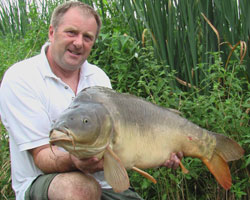Here’s an article from one of our field testers, Paul Cooper. Paul is one of a small band of very good anglers we send out to France to evaluate new venues for us. They often arrive with very little feedback to help them and they are under a lot of pressure to get the best returns, both for the owner and for Angling Lines. Paul is a very consistent carp angler who always seems to produce the goods and extract the best possible return from any lake we’ve sent him to. So I asked him to share with us how he does it;
The approach to a new lake in France can be a bit daunting at times especially when there is little or no literature available on the venue.
Before any new venue hits the Angling Lines website they go to great lengths to provide customers with as much information as possible on the venue and stock. To this end I get called on by Angling Lines several times a year to test fish new lakes and help provide the information.
In order to get the best possible return from my week at the lake I have developed a plan on how best to attack the fishing;
1. Before setting off from home I check on the weather web sites such as Metcheck, to find wind directions, air pressure and temperatures.
2. On arrival at the lake I speak to the bailiff or lake owner to get the heads up on possible productive parts of the lake.
3. I study the water for signs of feeding or patrolling fish
4. I do not rush to select a swim, but spend time with a marker rod, to establish depths and any underwater features, possible feeding areas such as gravel bars.
5. With a lead rod I try to find the weed beds, gravel beds, and try to find areas to avoid, such as soft stagnated silt or thick weed.
Taking all the information that I have gathered from the first few hours at the lake I will select a swim.
Now I want to get the maximum out of this swim for as long as possible;
1. The marker rod will be cast to my chosen area, which will always be in comfortable spodding range, even if I use a bait boat.
2. I will then mark up the spod rod and fishing rods to the marker rod.
3. I start by introducing about 4 or 5 kilo of either hemp, carp pellet, or partiblend along with around 100 boilies to an area the size of a large dining table.
4. I will cast 1 rod in the middle of the bait and the other 2 either side of the baited area.
5. I will not introduce any further bait until the runs start to develop.
6. Once I have selected my baited area I stick to it, drawing the fish to my dining table.
7. I DO NOT swap and change baiting locations, as all that happens is you spread the bait all over the swim.
8. Following the capture of each fish I will introduce another 10 spods of loose feed along with 20 to 30 boilies.
9. There is no need to use the marker rod again which could alarm the fish. The spod rod is marked so it can be cast to the same area on every cast. Boilies can accurately be introduced with a bait rocket on the same rod.
10. If more fish move in and a feeding frenzy occurs, I will increase the amount of bait and the frequency of baiting.
11. Weather conditions can change meaning the fish move off to another part of the lake. If this happens, & assuming it’s possible, I will move & follow the fish. If I do, I use the same procedure all over again.
12. It may be that you have to stay in a nominated swim. In this case ease off the bait until the fish return.
I have adopted this procedure for all my French fishing and have always had some considerable success. Hope it helps you!
Regards, Paul Cooper


Good advice there, particularly about staying put on a baited patch, I’ve seen loads of anglers get worried and move the rods off a baited patch only for the fish to turn up.